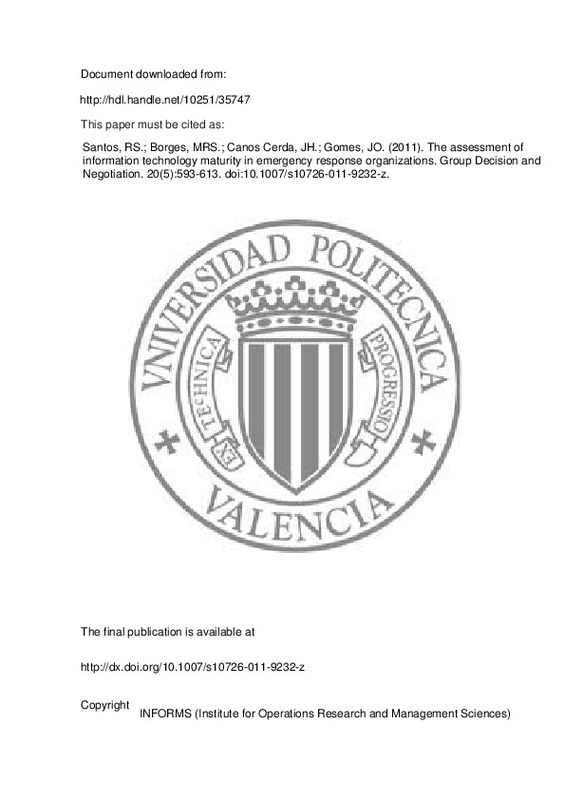Bigley G, Roberts KH (2001) The incident command system: high reliability organizing for complex and volatile task environments. Acad Manag J 44(6): 1281–1299
Chinowsky P, Molenaar K, Realph A (2007) Learning organizations in construction. J Manag Eng 23(1): 27–34
Diniz VB, Borges MRS, Gomes JO, Canós JH (2008) Decision making support in emergency response. In: Encyclopedia of decision making, Information Science Reference (an imprint of IGI Global), New York, pp 184–191
[+]
Bigley G, Roberts KH (2001) The incident command system: high reliability organizing for complex and volatile task environments. Acad Manag J 44(6): 1281–1299
Chinowsky P, Molenaar K, Realph A (2007) Learning organizations in construction. J Manag Eng 23(1): 27–34
Diniz VB, Borges MRS, Gomes JO, Canós JH (2008) Decision making support in emergency response. In: Encyclopedia of decision making, Information Science Reference (an imprint of IGI Global), New York, pp 184–191
Dörner R, Grimm P, Seiler C (2001) ETOILE—an environment for team, organizational and individual learning. CG Top 13(3): 5–6
Dykstra E (2003) Concept paper: toward an international system model in emergency management. In: Proceedings of toward an international system model in emergency management, Public Entity Risk Institute
Federal Emergency Management Agency (FEMA) (1998) Emergency management guide for business and industry: a step-by-step approach to emergency planning, response and recovery for companies of all sizes
Gu Q, Mendonça D (2005) Patterns of group information seeking in a simulated emergency response environment. In: Proceedings of the 2nd international ISCRAM conference, Brussels, Belgium
Hale J (1997) A layered communication architecture for the support of crisis response. J Manag Inf Syst 14(1): 235–255
King W, Teo T (1997) Integration between business planning and information systems planning: validating a stage hypothesis. Decis Sci 28(2): 279–307
Lachner J, Hellwagner H (2008) Information and communication systems for mobile emergency response. Lecture notes in business information processing, vol 5. pp 213–224
Lavoie D, Culbert A (1978) Stages in organization and development. Human Relat 31(5): 417–438
Lindel MK, Prater C, Perry RW (2007) Emergency management. Wiley, New York
Llavador M, Letelier P, Penadés MC, Borges MRS, Solís C (2006) Precise yet flexible specification of emergency resolution procedures. In: Proceedings of the information systems for crisis response and management (ISCRAM), pp 110–120
Meissner A, Wang Z, Putz W, Grimmer J (2006) MIKoBOS: a mobile information and communication system for emergency response. In: Proceedings of the 3rd international ISCRAM conference, Newark, New Jersey
Nonaka I, Takeuchi H (1995) The knowledge creating company: how Japanese companies create the dynamics of innovation. Oxford University Press, Oxford
Ochoa S, Neyem A, Pino JA, Borges MRS (2007) Supporting group decision making and coordination in urban disasters relief efforts. J Decis Syst 16(2): 143–172
Paton D, Flin R (1999) Disaster stress: an emergency management perspective. Disaster Prev Manag 8(4): 261–267
Paulk MC, Weber C, Curtis B, Chrissis M (1995) The capability maturity model: guidelines for improving the software process. Addison-Wesley, Reading
Quarantelli EL (1997) Problematical aspects of the information/communication revolution for disaster planning and research: ten non-technical issues and questions. Disaster Prev Manag 6(2): 94–106
Santos RS, Borges MRS, Gomes JO, Canós JH (2008) Maturity levels of information technologies in emergency response organizations. In: Proceedings of the international workshop on groupware, Omaha, Nebraska, USA. Groupware: design, implementation and use. Lecture notes in computer science, vol 5411. Springer, Berlin, pp 135–150
Schoenharl T, Szabo G, Madey G, Barabasi AL (2006) WIPER: a multi-agent system for emergency response. In: Proceedings of the 3rd international ISCRAM conference, Newark, New Jersey
Turoff M (2002) Past and future emergency response information systems. Commun ACM 45(4): 29–33
Turoff M, Chumer M, Hiltz R, Clasher R, Alles M, Vasarhelyi M, Kogan A (2004a) Assuring homeland security: continuous monitoring, control and assurance of emergency preparedness. J Inf Technol Theor Appl (JITTA) 6(3): 1–24
Turoff M, Chumer M, Vande Walle B, Yao X (2004b) The design of a dynamic emergency response management information system (DERMIS). J Inf Technol Theor Appl (JITTA) 5(4): 1–35
Van der Lee MDE, Van Vugt M (2004) IMI—An information system for effective multidisciplinary incident management. In: Proceedings of the 1st international ISCRAM conference, Brussels, Belgium
Yuan Y, Deltor B (2005) Intelligent mobile crisis response systems. Commun ACM 28(2): 95–98
Zimmerman R, Restrepo CE (2006) Information technology (IT) and critical infrastructure interdependencies for emergency response. In: Proceedings of the 3rd international ISCRAM conference, Newark, New Jersey
[-]







![[Cerrado]](/themes/UPV/images/candado.png)


